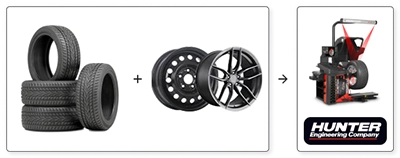Do I need winter tires in British Columbia? What about in Vancouver?

The experts at PMCtire urge BC motorists to choose the right tires for each season and region.
It's best to drive on summer tires during the summer months and winter tires when the temperature drops to 7°C. This ensures maximum safety and value for money in all conditions.
As for all-season tires, they cannot offer optimal performance in all conditions.
Over the years, many winter-related traffic accidents have been reported in British Columbia. But that number increased when Vancouver received an incredible amount of snow. When the next snowstorm hits the province's largest city, Vancouver, you'll be thankful you have winter tires.
In winter, you must drive slower and keep a safe distance between your car and others. Even though there isn't much snow in Vancouver, winter temperatures often drop below 7℃. And that's exactly when it's important to have winter tires on your vehicle because the performance of your tires is directly affected by the temperature.
Below 7℃, all-season and summer tires become stiffer, as they are unsuitable for such temperatures. This stiffness causes them to lose traction and reduce their braking performance, which can put your life at risk.
Winter tires have soft rubber and a tread specially designed to perform in cold weather. They offer optimal traction and reduced braking distance. They are much safer than all-season tires when driving in snow or ice. Statistics show that braking performance is up to 62% better for vehicles equipped with winter tires than those supplied with all-season tires.
The best and safest solution is to use two sets of tires: summer tires and winter tires. There are two main reasons why some people do not have two sets of tires: money and storage. However, these reasons are superficial. The reduced wear saves the money you spend on winter tires on your summer tires.
Are winter tires mandatory?
Winter tires or chains are required on most highways in British Columbia from October 1 to April 30.
For some highways that are not in mountain passes and/or high snowfall areas, the tire and chain requirements end on March 31.
These locations are identified by regulatory signs posted on highways throughout the province.

These signs are enforced by the police, ministry or other enforcement officials. Motorists who are not compliant may be turned away and fined.
British Columbia requires drivers to install winter tires if they plan to drive on specific highways where conditions are unpredictable, such as the Sea-to-Sky Highway.
Winter tires in the Lower Mainland and Southeast Vancouver Island
Due to the more temperate winter climate in the Lower Mainland and Southeast Vancouver Island, drivers are not required to use winter tires as well as in many areas along the coast.
However, remember that you are responsible for your vehicle based on road conditions. We strongly suggest you follow the example of many drivers who use M+S tires in these areas year-round.
If you regularly travel to more mountainous areas, not only are winter tires mandatory, but they are also safer.
Keep in mind that winter tires are mandatory on most highways if you plan to travel outside the Lower Mainland and southeast Vancouver Island.
Driving on studded tires in British Columbia?
Studded tires can only be used on BC roads from October 1 to April 30.
Studs must not extend more than 2 mm beyond the tread or traction surface of the tire. Use of studded tires outside of this period may result in a fine.
Before buying winter tires, you should assess your needs, starting with your travel habits. Do you travel mainly in the city, on the highway or back roads?
If you live in a rural area in the northern part of the province, if you often use back roads or have to go to the cottage on weekends, studded tires could save you a lot of trouble. You'll feel safer with studded tires because they provide highly effective braking and a good grip on ice.
If you use studded tires, you must put them on all four wheels to get even traction. If you use studded tires on the front of the vehicle, they should also be used on the rear.
Again, many people think that you can install only two winter tires on your vehicle. This is not a good idea: the result would be too unpredictable and could put your life in danger. Don't gamble with your life.


